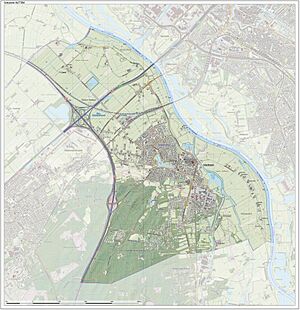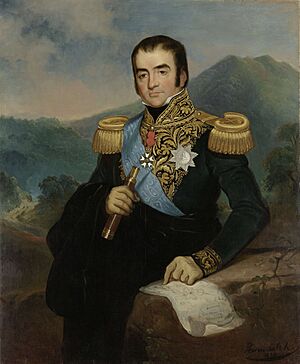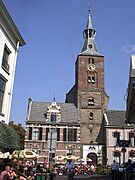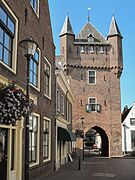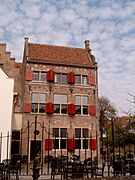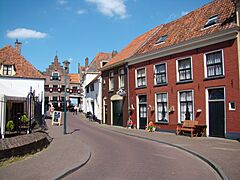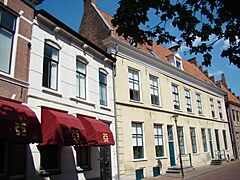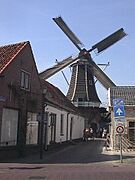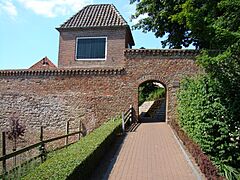Hattem facts for kids
Quick facts for kids
Hattem
|
|||
|---|---|---|---|
|
Municipality and city
|
|||
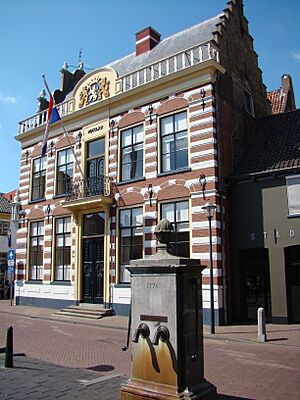
Hattem city hall
|
|||
|
|||
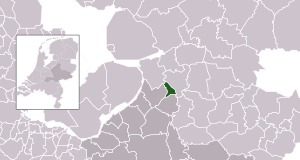
Location in Gelderland
|
|||
| Country | Netherlands | ||
| Province | Gelderland | ||
| Government | |||
| • Body | Municipal council | ||
| Area | |||
| • Total | 24.16 km2 (9.33 sq mi) | ||
| • Land | 23.11 km2 (8.92 sq mi) | ||
| • Water | 1.05 km2 (0.41 sq mi) | ||
| Elevation | 5 m (16 ft) | ||
| Population
(2023)
|
|||
| • Total | 12.569 | ||
| • Density | 545/km2 (1,410/sq mi) | ||
| Demonym(s) | Hattemer | ||
| Time zone | UTC+1 (CET) | ||
| • Summer (DST) | UTC+2 (CEST) | ||
| Postcode |
8050–8052
|
||
| Area code | 038 | ||
Hattem is a charming city and municipality located in the eastern part of the Netherlands. It is known for its rich history and beautiful surroundings. In 2023, about 12,569 people lived in Hattem. The municipality also includes a small area called 't Zand.
Contents
Name Origin
The name “Hattem” sounds like a typical name for an old farm area. No one is completely sure where the name came from. There are two main ideas. One idea is that Hattem means the ‘heem’ (which means home) of people from a tribe called Chattuarii. The other idea is that the name comes from a leader named Hatto. Many old farm names were created from people's names.
History of Hattem
The first time Hattem was mentioned in a document was around the year 800. This old document, called the Codex Laureshamensis, talks about two farmhouses in Hattem that were given to an abbey.
Becoming a Parish
Even though Hattem was mentioned early, it did not have a church for a long time. In 1176, Hattem became a "parish." This meant it had its own church and religious area. The first chapel was not built in the city center. It was built on a place called the Gaedsberg, or ‘Gods-mountain’. The borders of this parish were the same as the later borders of Hattem's official area.
Hattem received its city rights in 1299 from Reinoud I van Gelre, a landgrave. This meant Hattem could govern itself and build defenses. Before this, a fortified town was built on the northern edge of the Veluwe area. The city plan was made around the current church. The tower of this church is from the 12th century. This shows that there was a chapel in the city center even before the main parish church. When Hattem got city rights, both the religious and legal centers moved to the new church and city. The new church and the city were named after the apostle Andreas.
Later Important Events

In 1401, Duke William of Guelders gave the Hoenwaard area to the people of Hattem. This land was used to feed their animals and to make bricks for their homes. In 1404, a castle called St. Lucia was built. It was also known as the “Dikke Tinne,” which means "the fat merlon." This name came from its very thick walls, which were the thickest in the Netherlands at that time. In 1778, the castle was taken down. Its bricks were then used to build new houses.
In 1786, Hattem and another town, Elburg, became known as centers for the Patriottentijd. This was a political group that wanted to change how the country was run. However, these movements were stopped by stadtholder William V, who was the leader at the time.
What to See and Do
Hattem used to have a train station. It was open from November 21, 1887, until October 8, 1950.
The current mayor of Hattem is Marleen Sanderse. She is from the CDA political party.
Hattem is next to the beautiful forests of ‘De Veluwe’ and along the IJssel river. It offers many fun things to do:
- Enjoy cozy outdoor cafes.
- Visit interesting museums.
- Explore a variety of unique shops.
- Attend exciting events that happen every year.
Every two years, Hattem celebrates the De dikke tinne festival. This festival brings the city back to medieval times with a special atmosphere.
Sightseeing Spots
- Anton Pieck Museum
- Voerman Museum Hattem
- Bakkerij museum (Bakery Museum)
- Dijkpoort town gate
- Windmill De Fortuin
- De Grote of Andreaskerk (main church)
Famous People from Hattem
Many notable people have connections to Hattem:
- John III of Egmont (1438–1516): He was the first Count of Egmont and a leader in Holland, Zeeland, and West-Friesland.
- Herman Willem Daendels (1762-1818): A Dutch politician who became the 36th Governor-General of the Dutch East Indies from 1808 to 1811.
- Jan Voerman (1857–1941): A famous Dutch painter.
- Luite Klaver (1870–1960): A Dutch painter, lithographer, and inventor.
- Willem Jacob van Stockum (1910–1944): A mathematician who made important contributions to the theory of general relativity.
- Henri Wassenbergh (1924-2014): A Dutch academic, law professor, and writer.
- Robert Long (1943-2006): A Dutch singer and television presenter.
- Ellen Spijkstra (born 1957): A Dutch ceramic artist and photographer.
Sports Stars
- Jan van Raalte (born 1968): A football manager and former professional player. He played in 324 club games.
- Ellen Kuipers (born 1971): A former field hockey player. She won a bronze medal with her team at the 1996 Summer Olympics.
Gallery
-
House of Herman Willem Daendels
See also
 In Spanish: Hattem para niños
In Spanish: Hattem para niños




